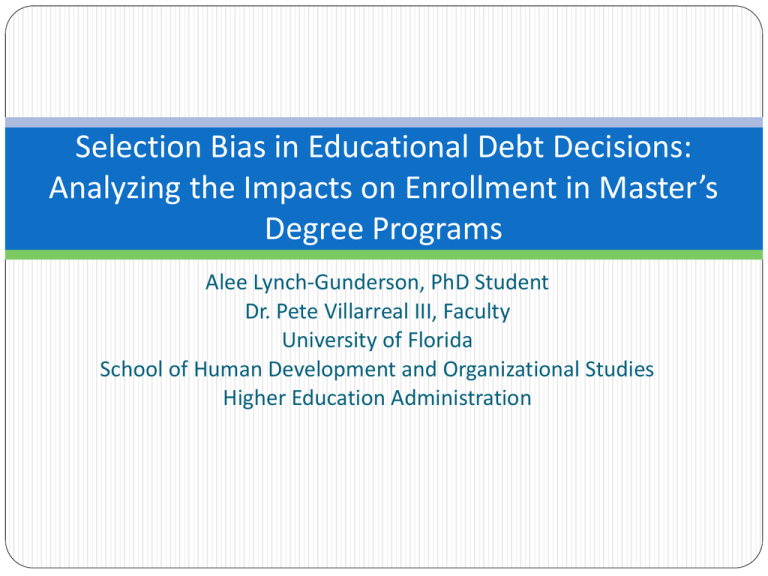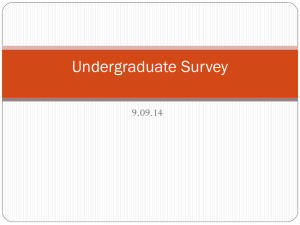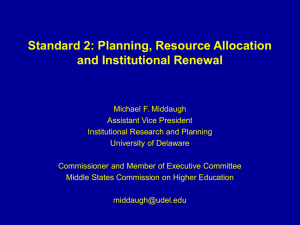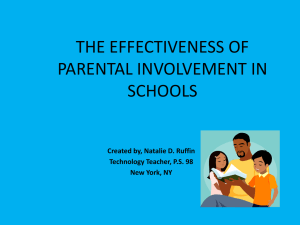
Selection Bias in Educational Debt Decisions:
Analyzing the Impacts on Enrollment in Master’s
Degree Programs
Alee Lynch-Gunderson, PhD Student
Dr. Pete Villarreal III, Faculty
University of Florida
School of Human Development and Organizational Studies
Higher Education Administration
Selected Citations
Millett (2003) “How Undergraduate Loan Debt Affects
Application and Enrollment in Graduate or First
Professional School”
Purpose: Effects of debts on students who are most
likely prospects for entering graduate and professional
school
Methodology: Logistic regressions
Sample: Recent bachelor’s degree recipients who expect
to earn a doctoral degree (1,982 cases)
Dataset: Baccalaureate and Beyond: 93/97
Key Limitation: Dataset did not distinguish types of
financial support
Selected Citations
Malcolm & Dowd (forthcoming) “College Student Debt as
Opportunity or Disadvantage? A Reconceptualization and
Application to STEM Graduate Enrollment”
Purpose: Effect of debt on graduate school attendance of
STEM majors
Methodology: Propensity Score Matching
Sample: STEM Bachelor’s recipients from 2000-01 & 2001-02
(7,700 cases)
Dataset: 2003 National Survey of Recent College Graduates,
2002-2003 College Board Annual Survey of Colleges and
Universities, Institute for College Access and Success,
Integrated Postsecondary Education Data System, & Barron’s
Profiles of American Colleges
Key Limitation: Exclusion of other master’s degree programs
Selected Citations
Perna (2004) “Understanding the Decision to Enroll in
Graduate School: Sex and Racial/Ethnic Group Differences”
Purposes:
Contribute to understanding of underrepresentation of women,
African Americans, and Hispanics among doctoral and professional
degree enrollees
Test a conceptual model for graduate school enrollment
Method: Multinomial logit models
Sample: Bachelor’s degree recipients in 1992-93 (9,241 cases)
Dataset: Baccalaureate and Beyond: 93/97
Key Limitation: Did not control for self-selection bias
Sex
• Male
• Female
Cultural & Social Capital
• Parental educational attainment
• Primary language at home is English
• Values additional education (B&B 11item)
• Parental monetary contribution
• Carnegie classification
• Tuition
• Location
• Attended two-year college
Financial & Academic
Resources
• Undergraduate Educational Debt
• Dependency status
• Time to Bachelor’s Degree
• Cumulative Undergraduate GPA
• SAT/ACT quartile
Race/Ethnicity
Perna’s
Enrollment
Decision
Conceptual
Model
• Asian
• Black
• Hispanic
• White
• other
Expected Costs & Benefits
• Net price
• Foregone earnings by undergraduate
major
• Time horizon (delayed college)
• Marital Status
• Parental Status
Cultural & Social Capital
•Parental educational attainment
•Primary language at home is English
•Values additional education (B&B
11-item)
•Parental monetary contribution
•Carnegie classification
•Tuition
•Location
•Attended two-year college
Sex
• Male
• Female
Cultural & Social Capital
• Parental educational attainment
• Primary language at home is English
• Values additional education (B&B 11item)
• Parental monetary contribution
• Carnegie classification
• Tuition
• Location
• Attended two-year college
Financial & Academic
Resources
• Undergraduate Educational Debt
• Dependency status
• Wen bachelor’s received
• Cumulative Undergraduate GPA
• SAT/ACT quartile
Race/Ethnicity
Perna’s
Enrollment
Decision
Conceptual
Model
• Asian
• Black
• Hispanic
• White
• other
Expected Costs & Benefits
• Net price
• Foregone earnings by undergraduate
major
• Time horizon (delayed college)
• Marital Status
• Parental Status
Expected Costs & Benefits
•Net price
•Foregone earnings by undergraduate
major
•Time horizon (delayed college)
•Marital Status
•Parental Status
Sex
• Male
• Female
Cultural & Social Capital
• Parental educational attainment
• Primary language at home is English
• Values additional education (B&B 11item)
• Parental monetary contribution
• Carnegie classification
• Tuition
• Location
• Attended two-year college
Financial & Academic
Resources
• Undergraduate Educational Debt
• Dependency status
• Wen bachelor’s received
• Cumulative Undergraduate GPA
• SAT/ACT quartile
Race/Ethnicity
Perna’s
Enrollment
Decision
Conceptual
Model
• Asian
• Black
• Hispanic
• White
• other
Expected Costs & Benefits
• Net price
• Foregone earnings by undergraduate
major
• Time horizon (delayed college)
• Marital Status
• Parental Status
Financial & Academic Resources
•Undergraduate Educational Debt
•Dependency status
•Time to Bachelor’s Degree
•Cumulative Undergraduate GPA
•SAT/ACT quartile
Student Characteristics
• Sex
• Race/Ethnicity
Cultural & Social Capital
• Parental educational attainment
• Primary language at home is English
• Values additional education (B&B 11item)
• Parental monetary contribution
• Carnegie classification
• Tuition
• Location
• Attended two-year college
• Parent’s have a mortgage
• Location of employment
Expected Costs & Benefits
• Net price
• Foregone earnings by undergraduate
major
• Time horizon (delayed college)
• Marital Status
• Parental Status
Modified
Enrollment
Decision
Conceptual
Model
Academic Resources
Financial Resources
• Time to Bachelor’s Degree
• Cumulative Undergraduate GPA
• SAT/ACT quartile
• Undergraduate Educational Debt
• Dependency status
• Type of Assistantship
Financial Resources
•Undergraduate Educational Debt
•Dependency status
•Type of Assistantship
Academic Resources
•Time to Bachelor’s Degree
•Cumulative Undergraduate GPA
•SAT/ACT quartile
Cultural & Social Capital
•Parental educational attainment
•Primary language at home is English
•Values additional education (B&B 11-item)
•Parental monetary contribution
•Carnegie classification
•Tuition
•Location
•Attended two-year college
•Parent’s have a mortgage
•Location of employment
Research Study
How does the likelihood of master’s program
enrollment vary by level of undergraduate educational
debt?
Contributions to Current Body of Research
Utilize propensity score methods to control for self-
selection bias
Control for differing effects between types of financial
support
National dataset includes students from all master’s
degree program areas
Dataset: National Postsecondary Student Aid Study 2008
What’s Next?
January – Submission for an AIR Research Grant
January to May – Conduct analyses
May – Submission for research presentation at ASHE
December – Submit to journal for publication









